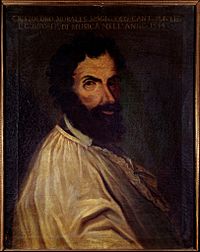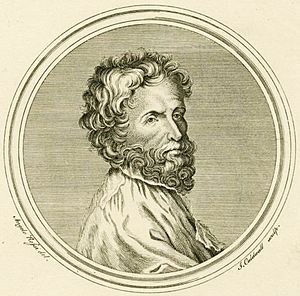Cristóbal de Morales facts for kids
Cristóbal de Morales (born around 1500 – died in 1553) was a famous Spanish composer from the Renaissance period. Many people think he was the most important Spanish composer before Tomás Luis de Victoria.
Contents
Life of a Renaissance Composer
Cristóbal de Morales was born in Seville, Spain. He had a great early education there, learning about classic subjects and music from top composers. He later worked in cities like Ávila and Plasencia.
In 1535, Morales moved to Rome, Italy. He became a singer in the choir for the Pope, Pope Paul III. The Pope especially liked Spanish singers. Morales worked for the Vatican in Rome until 1545. After that, he tried to find other jobs in Italy but wasn't successful.
He then returned to Spain and held several jobs. Sometimes, he faced money or political problems. Even though he was known as one of Europe's greatest composers, he sometimes found it hard to keep jobs. People said he was a bit difficult to work with.
Many people praised Morales. A Spanish music expert named Juan Bermudo called him "the light of Spain in music." In 1559, a choir in Mexico even sang his music to remember the death of Emperor Charles V. This shows how far his music traveled!
Morales was known for being very talented. He might have seemed a bit proud and didn't always get along with musicians who weren't as skilled. He expected a lot from the singers he worked with. But despite this, he was still seen as one of the best composers in Europe in the mid-1500s.
On September 4, 1553, he wanted to get a job at the Cathedral of Toledo, where he had worked before. But he died shortly after in Marchena, sometime before October 7.
Morales's Music and Influence
Almost all of Cristóbal de Morales's music was sacred, meaning it was for religious purposes. All of his pieces were for voices, though instruments might have played along sometimes.
He wrote many masses, which are long musical pieces for church services. Some of these were very difficult and were likely written for the expert papal choir. He also wrote over 100 motets, which are shorter religious songs.
One of his most famous works is his 18 settings of the Magnificat. These are songs based on a prayer from the Bible. His Magnificats are what make him stand out from other composers of his time, and they are often performed today. He also wrote at least five settings of the Lamentations of Jeremiah, which are sad songs from the Bible.
Morales's music sounds a lot like other music from Spain during the Renaissance. He often used harmonies that sound familiar to us today. His style also had unique features, like rhythmic freedom. Sometimes, different voices in his music would sing in different rhythms at the same time. He always made sure the words of his songs were clear and easy to understand.
Morales was the first Spanish composer to become famous internationally. His music was shared widely across Europe, and many copies even reached the New World (the Americas). For about a hundred years after he died, many music writers thought his music was some of the most perfect of its time.
His Famous Masses
Morales wrote 22 masses that we still have today. He used different ways to compose them. For example, he used a technique called cantus firmus, where he based a new piece on an existing melody. He also used parody mass, where he took parts from another piece of music and used them in his mass.
Six of his masses are based on Gregorian chant, which are old church melodies. Eight of his masses use the parody technique. One famous example is a mass for six voices based on the well-known song "Mille regretz" (meaning "A Thousand Regrets"), which was likely written by Josquin des Prez. In this mass, you can clearly hear the original melody in every part of the piece.
Morales also wrote two masses using the famous "L'homme armé" (meaning "The Armed Man") tune. Many composers in the 1400s and 1500s used this tune. One of Morales's "L'homme armé" masses is for four voices, and the other is for five.
He also wrote a Missa pro defunctis, which is a Requiem mass (a mass for the dead). This might have been one of his last works.
List of Works
- 22 masses
- Missarum Liber primus (published in Rome, 1544)
- Missa Aspice Domine (4 voices)
- Missa Ave Maris Stella (4 voices)
- Missa De Beata Virgine (4 voices)
- Missa L'homme armé (5 voices)
- Missa Mille Regretz (6 voices)
- Missa Quaeramus cum pastoribus (5 voices)
- Missa Si bona suscepimus (6 voices)
- Missa Vulnerasti cor meum (4 voices)
- Missarum Liber secundus (published in Rome, 1544)
- Missa Benedicta est regina caelorum [also called Missa Valenciana] (4 voices)
- Missa De Beata Virgine (5 voices)
- Missa Gaude Barbara (4 voices)
- Missa L’homme armée (4 voices)
- Missa Pro defunctis (5 voices)
- Missa Quem dicunt homines (5 voices)
- Missa Tu es vas electionis (4 voices)
- Other masses:
- Missa Caça
- Missa Cortilla
- Missa Desilde al cavallero (4 voices)
- Missa Super Ut re mi fa sol la (4 voices)
- Missa Tristezas me matan (5 voices)
- Officium defunctorum (4 voices, written around 1526–28)
- Missarum Liber primus (published in Rome, 1544)
- 18 settings of the Magnificat
- 5 Lamentations of Jeremiah
- Over 100 motets
Recordings of Morales's Music
- Cristóbal de Morales, Messe Mille Regretz. Victor Alonso, Concert de les Arts. CD Accord 204662.
- Cristóbal de Morales, Missa de Beata Virgine (a5). Collegium Vocale Gent, Philippe Herreweghe. The V. Sessions, 2009.
- Cristóbal de Morales, Missa de Beata Virgine. Ensemble Jachet de Mantoue. CD Calliope 9363.
- Cristóbal de Morales, Missa mille regretz. Paul McCreesh, Gabrieli Consort & Players. CD Archiv 474 228-2.
- Cristóbal de Morales, Missa Si bona suscepimus. The Tallis Scholars, Peter Phillips. Gimell CDGIM 033.
- Cristóbal de Morales, Missa Vulnerasti cor meum. – Canticum Canticorum. Orchestra of the Renaissance, Richard Cheetham, Michael Noone. Glossa cabinet GCD C81403.
- Cristóbal de Morales, Morales en Toledo. Michael Noone, Ensemble Plus Ultra. GCD 922001
- Cristóbal de Morales, Office des Ténèbres. Denis Raisin-Dadre, Doulce Mémoire. Naïve E 8878
Office of the Dead/Requiem Recordings
- Cristóbal de Morales, Officium (Parce mihi Domine). Jan Garbarek and the Hilliard Ensemble. ECM 1525
The song 'Parce mihi Domine' from his Officium Defunctorum was a key track on the very popular 1994 album Officium, by Jan Garbarek and the Hilliard Ensemble.
- Cristóbal de Morales, Morales: Requiem. Paul McCreesh, Gabrieli Consort. CD Archiv 457 597-2
- Cristóbal de Morales, Officium defunctorum, Missa pro Defunctis. La Capella Reial de Catalunya, Hespèrion XX, Jordi Savall. Naive ES 9926.
See also
 In Spanish: Cristóbal de Morales para niños
In Spanish: Cristóbal de Morales para niños



